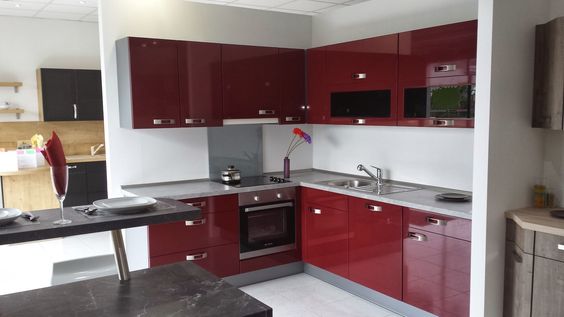Kitchen cabinets may become soggy as a result of a flood or leak. Cabinets made of particle board are particularly vulnerable to water damage. They can swell, break, or even fall apart if they contact even a slight amount of water. Water, on the other hand, can rot MDF and solid wood cabinets. The trick to repairing water-damaged cabinets is to get rid of the water as soon as possible. Our instructions will show you how to patch water-damaged kitchen cabinets. If your kitchen cabinets have been damaged by water, take the steps below to dry and restore them.
- Take everything out of the cabinets.
It would help if you first emptied the cabinets. Food should be packed in glass or plastic tubes, so something in a package or bag can be thrown out. Towels and other materials should be washed, and paper products should be discarded.
- Drain the Water
The next step is to get rid of as much water as possible. Otherwise, it will keep soaking into your cabinets, causing further harm. To drain the sweat, use thick towels or blankets. And, using towels or rags, rinse the kitchen cabinets. Your cabinets should be dry to the touch at this stage.
- Take out the cabinet doors
It’s also a good idea to take down the gate. This will not only speed up the drying process but will also limit the damage. Because of the weight of the gate, the particleboard can sag or crumble. Move the doors to a nearby space and dry them with high-volume fans. To prevent them from warping, lay them out flat.
- Wet and Dry Cabinets
Start drying the damp kitchen cabinets now that the doors are out of the way. Usage of household fans, on the other hand, should be avoided. The particleboard would take too long to dry out. Your cabinets are more likely to break out until they dry. Instead, rent high-volume fans and structural drying dehumidifiers from a business that rents out appliances. With two or three fans and a dehumidifier, you can dry out the cabinets in an average-sized kitchen in about a day.
Every four hours, check the cabinets and reposition the fans if necessary. Remember to dry behind and under the kitchen cabinets as well.
- Patch the Kitchen Cabinets.
You will be able to patch kitchen cabinets depending on the degree of the water loss. Unless the water has delaminated portions of the cabinet, fix the damage with the carpenter’s glue and clamps. Apply carpenter’s glue between the delaminated cabinet layers, then clamp them back together. Screw 24 boards in as brackets to help straighten out bent or bloated cabinets. Screw further into the back of the door to cover the injury. Remove the braces until the cabinets and doors have been cleaned.
- Replacing Cabinets That Have Been Damaged
Water-damaged cabinets aren’t necessarily salvageable. Chipboard cabinets are more likely than solid wood cabinets to come apart because water weakens the glue. No quantity of glue will save them until they begin to crumble.
The only way to fix this is to take out the broken cabinets and replace them with new ones. If you can’t find matching cabinets, you’ll have to paint or veneer them to make them fit.
- Stains from Clear Water
And if you save your flood-damaged cabinets, water stains are almost certain to remain. Oxalic acid is the most effective way to get rid of water stains on wood. You’ll have to sand the polish off first, unfortunately.
Follow the instructions on the bottle when mixing oxalic acid with water. Then add the solution to your painted cabinets with a brush and wait for it to dry. For minor stains, one coat can suffice, but at least two are needed.
You must neutralize the acid until the stain is removed. Mix half a cup of baking soda with a gallon of water and scrub the cabinets. The cabinets could then be rinsed and dried thoroughly.
- Deodorize and disinfect the area
Even if your cabinets are completely dry, odors and mold will form over time. Wipe off the cabinets with a one-cup-per-gallon-of-water bleach solution. Mold and bacteria will be killed, and odors will be eliminated.
Opening the windows will also help you get rid of odors. Sprinkle baking soda on scents at night and vacuum it up the next day. You may have to do this a couple of times before the baking soda absorbs any odors.
Cabinets should be refinished at least once every few years.
Water damage to kitchen cabinets can necessitate refinishing in some cases. To clear the original finish, lightly sand the wood. Then wipe down the wood with a damp rag to remove dust and dirt before allowing it to dry naturally. Apply a sealant to the wood to secure it, provide a foundation for the paint, and then stain it evenly. To ensure the wood, apply a finish coat or topcoat to obey the manufacturer’s directions.
Why does water damage Kitchen Cabinets?
Water is an excellent solvent that can degrade or even kill almost everything. However, the way kitchen cabinets are designed is an essential aspect in preventing water harm. Almost all kitchen cabinets use particleboard. This is a broad category of processed wood products made by gluing together small pieces of wood. Often, a veneer is applied to the exterior of the particle board to give it a more sturdy appearance.
When participle board cabinets get damp, two unfortunate situations occur. The wood initially collects the water and swells. Second, the water begins to melt the cabinet’s glue. The cabinet would disintegrate faster as the wood contains more water. As a result, it’s essential to drain the water as soon as possible and begin drying your cabinets. You can hire a repair firm if you don’t have the time or equipment to do it yourself.
